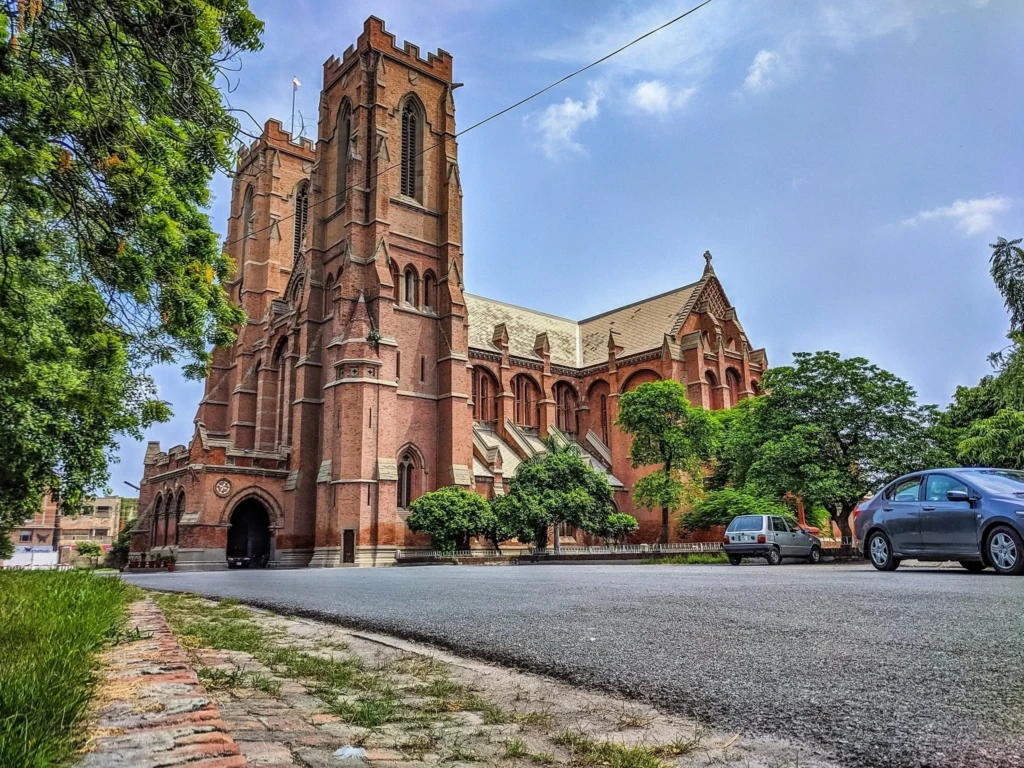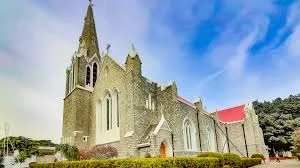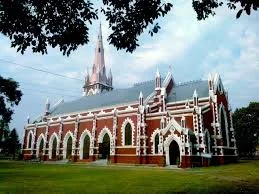When we think of Punjab, we often picture colorful festivals, Mughal-era forts, Sufi shrines, and bustling bazaars. But hidden within the heart of this vibrant province are centuries-old churches—beautiful testaments to faith, history, and architecture. These famous churches of Punjab aren’t just structures; they carry the stories of communities, resilience, and religious diversity. Let’s take you on a spiritual and historical journey through the famous churches to visit in Punjab, Pakistan.
1. Cathedral Church of the Resurrection – Lahore
Location: The Mall Road, near Lahore High Court, Lahore
Built in: 1887
Architectural Style: Gothic Revival
Located in the historic heart of Lahore on The Mall Road, the Cathedral Church of the Resurrection is one of the most prominent and majestic among the famous churches of Punjab.
Built during the British Raj, its Gothic Revival design features red sandstone walls, high-arched stained glass windows, a grand bell tower, and a pipe organ that still echoes hymns from time to time.
It was designed by architect John Oldrid Scott, son of the renowned Sir George Gilbert Scott, and opened for worship in 1887. The church once had an even taller spire, which was unfortunately struck by lightning in 1911 and never rebuilt to its original height.

Current Status: The church is well-preserved, frequently maintained, and actively hosts Sunday services, special masses, weddings, and Christmas celebrations. Its peaceful garden and old wooden pews offer a nostalgic spiritual atmosphere that attracts both worshippers and curious visitors.
Worth Visiting For:
- The serene courtyard and British-era cemetery
- The historical plaque of Queen Victoria
- A sacred pause in the rush of the everyday.
2. Sacred Heart Cathedral – Lahore
Location: Lawrence Road, Lahore
Built in: 1907
Architectural Style: Italian-Mughal fusion
More than just the seat of the Archbishop of Lahore, this Roman Catholic cathedral is a true masterpiece of design and devotion. Constructed in 1907 to commemorate the golden jubilee of Pope Pius X, Sacred Heart Cathedral was designed by Belgian architect Dr. M. Dubbeleere.
Its architectural style is unique, blending Italian Romanesque arches with Mughal domes—a fusion that reflects the cultural crossroads of colonial Lahore. The twin bell towers, marble altar, and stained glass windows depicting biblical scenes make it spiritually and visually captivating.

Current Status: In excellent condition. The church is the center of many religious festivals including Easter, Good Friday, and Christmas. On Sundays and religious holidays, the pews fill with Lahore’s Catholic families, echoing with prayers and hymns in Urdu and English.
Worth Visiting For:
- The blend of Eastern and Western architecture
- Active participation of local Christian community A tranquil interior perfect for reflection
- A tranquil interior perfect for reflection
3. Holy Rosary Cathedral – Faisalabad
Location: Circular Road, Faisalabad
Built in: 1965
Architectural Style: Modern Colonial
The Cathedral of Sts. Peter and Paul, popularly known as Holy Rosary Church, is the spiritual center for Catholics in Faisalabad. Built in the mid-1960s, this church replaced a smaller structure to accommodate the growing community.
Though newer than other churches on this list, it still exudes a colonial aura. The architecture is simple but striking, with tall whitewashed walls, stained glass, and a towering cross visible from afar.
Current Status: Fully functional and active. The church is well-kept and regularly hosts masses, religious processions, catechism classes, and charity drives. The adjacent school and parish hall reflect its role as a vibrant community hub.
Worth Visiting For:
- A living center of community faith
- Modern yet deeply rooted in tradition
- Friendly atmosphere for visitors and worshippers
4. St. Paul’s Church – Rawalpindi
Location: Murree Road, near Liaquat Bagh, Rawalpindi
Built in: 1852
Architectural Style: Early Colonial
St. Paul’s Church is one of the oldest churches in Punjab, built by the British in 1852 for their officers stationed in Rawalpindi. The church’s architecture is modest yet elegant, featuring stone masonry, wooden rafters, and arched entrances that reflect the Anglican simplicity of that era.
It was a spiritual home for British soldiers and their families and now serves as a sacred place for local Christians.

Current Status: Although aged, the church is still functional and well-respected. Regular Sunday services and festive masses are held here, particularly during Christmas and Easter. The surrounding grounds and graveyard have stories carved into each weathered tombstone.
Worth Visiting For:
- Historical depth and colonial charm
- Close proximity to other historic landmarks
- A living relic of Rawalpindi’s multicultural past
5. Christ Church – Sialkot
Location: Kutchery Road, near the Sialkot Cathedral School
Built in: 1852
Architectural Style: Neo-Gothic
Built in 1852, Christ Church Sialkot is among the earliest churches established in Punjab during British colonial rule. With its pointed archways, lancet windows, and stone structure, it follows the classic Neo-Gothic design of 19th-century Anglican churches.
This church played a significant role in the lives of British civil servants, missionaries, and native converts. It continues to be a spiritual landmark for the Christian population of Sialkot.

Current Status: The church is well-maintained and still used for regular worship services, weddings, and seasonal celebrations. The original structure remains mostly intact, and both locals and tourists appreciate its historical value.
Worth Visiting For:
- Its antiquity and preservation
- Neo-Gothic elements A peaceful step back in time
- A peaceful step back in time
6. St. Joseph’s Church – Gujranwala
Location: Jinnah Road, Gujranwala
Built in: 1935
Architectural Style: Colonial with local influences
Since its founding in 1935, St. Joseph’s Church has been the spiritual heart of Gujranwala’s Catholic community. While modest in size compared to others, it serves as a spiritual home to hundreds of Christian families in the city.
Its architecture reflects colonial simplicity, featuring cream-colored brickwork, rounded arches, and an open layout. The adjacent school and community hall reflect the church’s active involvement in education and social welfare.

Current Status: Fully functional and well-attended. Community gatherings, Holy Mass, choir practices, and charity events are held regularly. It’s especially lively during Christmas and Easter seasons, when the church is decorated with lights and nativity displays.
Worth Visiting For:
- Community-driven faith center
- Modest yet meaningful presence
- Welcoming vibe for all visitors
Why These Churches Matter
These churches are not just relics of the past—they are living symbols of faith, diversity, and architectural splendor. In a region rich with mosques, shrines, and temples, these sacred Christian spaces add another layer to Punjab’s spiritual and cultural landscape. They serve as a reminder that Pakistan’s story is one of religious coexistence and shared heritage.
Final Thoughts
If you’re planning to explore the religious or historical landmarks of Punjab, don’t just stop at forts and mosques—take time to walk through the famous churches of Punjab. Sit on a century-old pew. Gaze at stained glass that’s filtered sunlight for over a hundred years. Listen to the soft echo of hymns that continue to rise in prayer.
Because these churches aren’t just places—they’re experiences.

